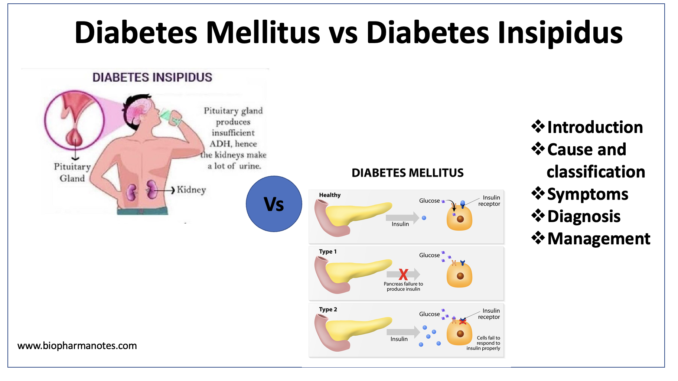
- Diabetes mellitus (DM) and diabetes insipidus (DI) are two different medical condition having the same first word of their name ‘diabetes’. They may have some similar features but other than that, these two diseases are completely unrelated to each other.
- The term ‘diabetes’ means to go through or siphon which indicate large amount of urine production by kidneys. The ‘Mellitus’ term is derived from Latin which means sweet. The term ‘insipidus’ in Latin means tasteless. In previous time, people used to diagnose diabetes by tasting urine. If the urine is sweet, the disease is diagnosed as diabetes mellitus and if it is tasteless, it is diagnosed as other disease like diabetes insipidus.
- The difference between these two diseases is explained in term of cause, symptoms, diagnosis, and treatment.
Cause and Classification
- Diabetes mellitus results from inadequate secretion or activity of insulin. Diabetes insipidus is caused due to inadequate secretion of ADH (Antidiuretic hormone) or due to inability of kidneys to respond to ADH.
- Major types of DM are:
- Type 1 DM caused due to inadequate secretion of insulin due to destruction of beta cells.
- Type 2 DM caused due to low target cell sensitivity to insulin (also called as insulin resistance).
- Gestational DM can occur during pregnancy.
- Some major types of DI are:
- Central diabetes insipidus caused due to inadequate secretion of ADH.
- Nephrogenic diabetes insipidus caused due to inability of kidneys to respond to ADH which may be due to genetic defect in either aquaporin channel or in ADH receptors.
- Dipsogenic DI which may occur due to hypothalamus damage due to inflammation, infection, or surgery or due to some medications.
- Gestational DI which occurs in pregnant woman.
Symptoms
- Some symptoms like frequent urination and increased thirst are common in both. However, their causes are different. Increased thirst in DM is due to excessive level of glucose in blood whereas in DI is due to fluids leaving from body. Urination is less frequent in DM compared to DI.
- Other symptoms of DI include nocturia (excessive urination at night) and dilute urine.
Diagnosis
- Diabetes mellitus can be diagnosed by measuring blood glucose level in which FBS (fasting blood sugar) level is measured in fasting condition. Normal range of FBS is 70 mg/dl to 100 mg/dl. It can also be diagnosed by glycated hemoglobin test or A1c. The normal range of A1c should be between 4% to 5.6%.
- Diabetes insipidus can be diagnosed by blood test in which sodium level is measured or by urinalysis. Fluid deprivation test and MRI (Magnetic Resonance Imaging) also can be used.
Management
- Both DI and DM cannot be completely cured but they can be managed. Treatment of DI depend on its type. In mild case of DI, patients are usually suggested to drink plenty of water. DI patients are administered with dextrose containing IV solutions. Central DI is usually treated by using drugs like desmopressin (synthetic hormone), chlorpropamide, thiazide diuretics. Nephrogenic DI is usually treated by treating the lying cause. Diuretics can also be used.
- Treatment options include lifestyle modifications like healthy diet, weight reduction, doing exercise etc. Type 1 diabetes is treated by using insulin therapy. Insulin may be short acting, intermediate acting, longa acting and rapid acting. Type 2 diabetes is treated by using oral hypoglycemic agents like metformin, repaglinide, rosiglitazone and voglibose.
References
- https://www.webmd.com/diabetes/guide/glycated-hemoglobin-test-hba1c
- https://www.jems.com/exclusives/diabetes-mellitus-and-diabetes-insipidus/
- https://www.webmd.com/diabetes/diabetes-insipidus-vs-diabetes-mellitus
- https://www.medicinenet.com/diabetes_insipidus/article.htm
- https://www.ucsfhealth.org/conditions/diabetes-mellitus/treatment
- Crain MC etal. Diagnosis and Management of diabetes insipidus for the internist: an update. JIM. 2021; 290: 73-87.